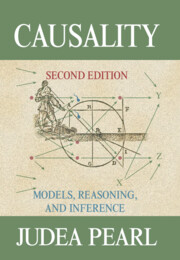Book contents
- Frontmatter
- Dedication
- Contents
- Preface to the First Edition
- Preface to the Second Edition
- 1 Introduction to Probabilities, Graphs, and Causal Models
- 2 A Theory of Inferred Causation
- 3 Causal Diagrams and the Identification of Causal Effects
- 4 Actions, Plans, and Direct Effects
- 5 Causality and Structural Models in Social Science and Economics
- 6 Simpson’s Paradox, Confounding, and Collapsibility
- 7 The Logic of Structure-Based Counterfactuals
- 8 Imperfect Experiments: Bounding Effects and Counterfactuals
- 9 Probability of Causation: Interpretation and Identification
- 10 The Actual Cause
- 11 Reflections, Elaborations, and Discussions with Readers
- Epilogue The Art and Science of Cause and Effect
- Bibliography
- Name Index
- Subject Index
3 - Causal Diagrams and the Identification of Causal Effects
Published online by Cambridge University Press: 05 March 2013
- Frontmatter
- Dedication
- Contents
- Preface to the First Edition
- Preface to the Second Edition
- 1 Introduction to Probabilities, Graphs, and Causal Models
- 2 A Theory of Inferred Causation
- 3 Causal Diagrams and the Identification of Causal Effects
- 4 Actions, Plans, and Direct Effects
- 5 Causality and Structural Models in Social Science and Economics
- 6 Simpson’s Paradox, Confounding, and Collapsibility
- 7 The Logic of Structure-Based Counterfactuals
- 8 Imperfect Experiments: Bounding Effects and Counterfactuals
- 9 Probability of Causation: Interpretation and Identification
- 10 The Actual Cause
- 11 Reflections, Elaborations, and Discussions with Readers
- Epilogue The Art and Science of Cause and Effect
- Bibliography
- Name Index
- Subject Index
Summary
The eye obeys exactly the action of the mind.
Emerson (1860)Preface
In the previous chapter we dealt with ways of learning causal relationships from raw data. In this chapter we explore the ways of inferring such relationships from a combination of data and qualitative causal assumptions that are deemed plausible in a given domain. More broadly, this chapter aims to help researchers communicate qualitative assumptions about cause–effect relationships, elucidate the ramifications of such assumptions, and derive causal inferences from a combination of assumptions, experiments, and data. Our major task will be to decide whether the assumptions given are sufficient for assessing the strength of causal effects from nonexperimental data.
Causal effects permit us to predict how systems would respond to hypothetical interventions – for example, policy decisions or actions performed in everyday activity. As we have seen in Chapter 1 (Section 1.3), such predictions are the hallmark of the empirical sciences and are not discernible from probabilistic information alone; they rest on – and, in fact, define – causal relationships. This chapter uses causal diagrams to give formal semantics to the notion of intervention, and it provides explicit formulas for postintervention probabilities in terms of preintervention probabilities. The implication is that the effects of every intervention can be estimated from nonexperimental data, provided the data is supplemented with a causal diagram that is both acyclic and contains no latent variables.
If some variables are not measured then the question of identifiability arises, and this chapter develops a nonparametric framework for analyzing the identification of causal relationships in general and causal effects in particular. We will see that causal diagrams provide a powerful mathematical tool in this analysis; they can be queried, using extremely simple tests, to determine if the assumptions available are sufficient for identifying causal effects. If so, the diagrams produce mathematical expressions for causal effects in terms of observed distributions; otherwise, the diagrams can be queried to suggest additional observations or auxiliary experiments from which the desired inferences can be obtained.
Another tool that emerges from the graphical analysis of causal effects is a calculus of interventions – a set of inference rules by which sentences involving interventions and observations can be transformed into other such sentences, thus providing a syntactic method of deriving (or verifying) claims about interventions and the way they interact with observations.
- Type
- Chapter
- Information
- CausalityModels, Reasoning, and Inference, pp. 65 - 106Publisher: Cambridge University PressPrint publication year: 2009
- 8
- Cited by



